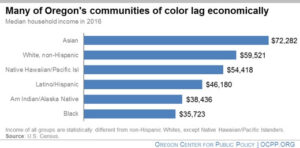Statement by OCPP policy analyst Janet Bauer
Today’s Census data shows that while a growing economy has helped Oregon recover ground lost since the last recession, Oregon’s communities of color have struggled to share in the benefits.
In 2016, Oregon median household income — the income of the household in the middle of the income ladder — increased by about $1,100 to $57,532 from the year before. This is good news, enough to make up for income losses since 2007, adjusted for inflation.

The poverty rate in Oregon stood at 13.3 percent in 2016, Census data showed, a decline of 2.0 percentage points from the prior year. That was about the same as the poverty level in Oregon in 2007 (12.9 percent), before the start of the Great Recession.
In further positive news, the share of children experiencing poverty in 2016 fell to 16.2 percent, from 21.8 percent in 2015. That brought the rate back down to the pre-recession level. While there are 137,000 Oregon children still suffering in poverty, the overall progress is encouraging.
Many of Oregon’s communities of color faced significant barriers to economic security. While the median income for non-Hispanic Whites in 2016 was $59,521, the median income for Latinos, American Indians and Alaskan Natives, and Blacks was substantially lower, at $46,180, $38,436 and $35,723, respectively. Only non-Hispanic Whites saw a significant increase in median income over the prior year.
Likewise, while 11.1 percent of non-Hispanic Whites in Oregon lived below the official poverty line in 2016, communities of color fared much worse. In 2016, 14.3 percent of Asians, 21.6 percent of Native Hawaiian and Pacific Islanders, 22.1 percent of American Indian and Alaska Natives, 22.6 percent of Latinos, and 27.0 percent of Blacks in Oregon lived below the poverty line. Only non-Hispanic Whites and Latinos saw significant declines in poverty rates over the prior year.
The fact that many Oregonians lack economic security hobbles our economy. Most Oregon families that struggle to make ends meet are working families, yet are paid wages too low to afford the basics.
Oregon can take steps to boost the work effort of Oregon families, including many in Oregon’s communities of color who struggle to make ends meet. For example, lawmakers should increase Oregon’s time-tested Earned Income Tax Credit and prevent employers from stealing the wages of their workers.





